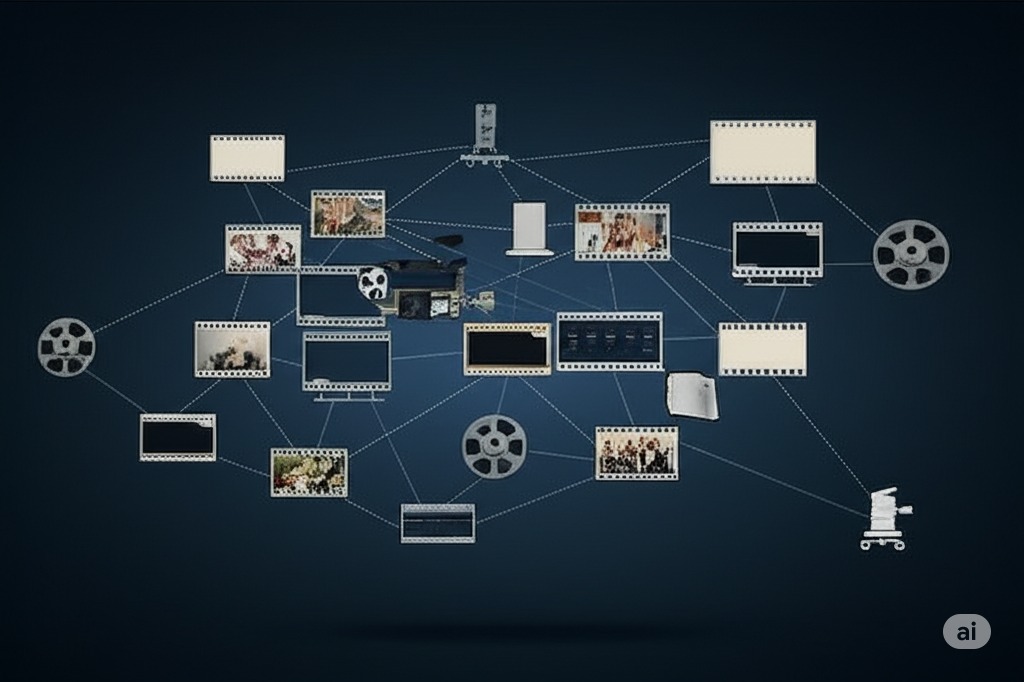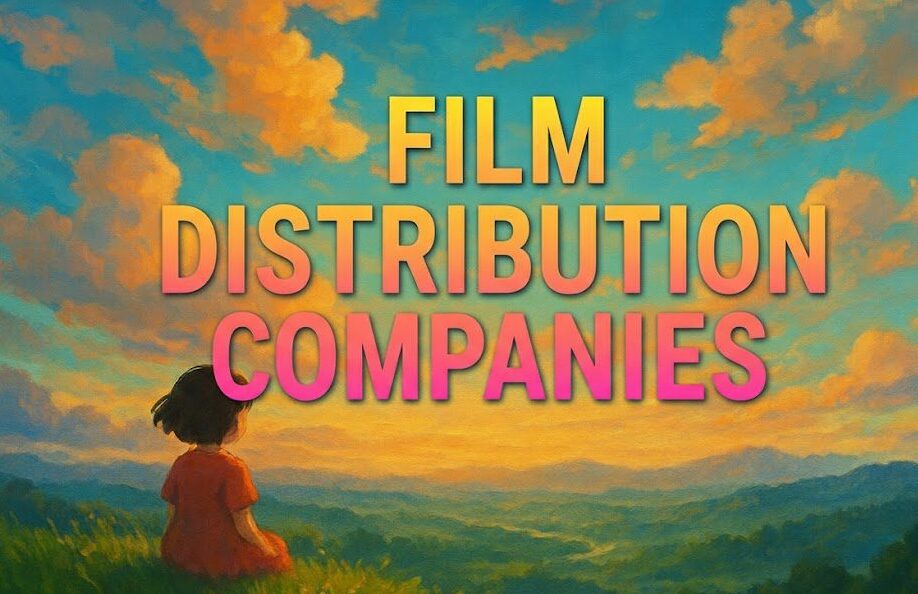Introduction
So, you’ve poured your heart, soul, and budget into making a film. That’s a huge win! But what comes next? Getting your movie seen by audiences around the world is a whole other adventure. This is where film distribution and sales come into play. It’s a super important part of the movie business.
This guide will walk you through the ins and outs, helping you, as a global producer or sales agent, understand how to get your film out there and making money. We’ll look at who does what, the different ways to release a film, and how to plan for success in today’s fast-changing market.
Table of content
- Introduction
- Key-Takeaways
- Understanding the Landscape of Film Distribution and Sales
- The Essential Players: Who Makes Film Distribution and Sales Happen?
- Choosing Your Path: Navigating Different Distribution Models
- Crafting Your Global Strategy: Tips for Producers in Film Distribution and Sales
- Understanding the Fine Print: Deals, Windows, and Revenue
- How Vitrina Champions Your Film Distribution and Sales Efforts
- Overcoming Hurdles and Peering into the Future of Film Distribution and Sales
- Conclusion
- FAQs
Key Takeaways
| Aspect | Key Insight |
|---|---|
| Understanding the Basics | Film distribution and sales involve licensing your film to various platforms and territories so audiences can watch it. |
| Key Players | Distributors and sales agents are crucial partners who help navigate the market and secure deals. |
| Distribution Models | There are many ways to release a film, from traditional cinemas to digital streaming platforms and even self-distribution. |
| Global Strategy | Success often means thinking globally, understanding international markets, and leveraging film festivals. |
| Deals and Revenue | Understanding distribution agreements, sales windows, and how revenue flows back is vital. |
| Vitrina’s Role | Platforms like Vitrina can connect you with partners and provide market intelligence to support your film distribution and sales efforts. |
Struggling to Find Distribution Partners?

Understanding the Landscape of Film Distribution and Sales
Getting a film from the final cut to an audience involves many steps. It’s not just about making a great movie; it’s about making sure people can see it! That’s the core of film distribution and sales. Think of it like this: filmmakers create the art, and distributors and sales teams build the bridges to the viewers.
What Exactly is Film Distribution?
Film distribution is the process of making a movie available to an audience. This used to mainly mean getting it into movie theaters. Now, it includes a whole lot more, like streaming services, TV broadcasts, DVD releases (yes, still!), and even showing films on airplanes. The main goal is to reach the widest possible audience that makes sense for your specific film. For a producer, a good distribution plan means your hard work gets seen and has a chance to earn back its investment, and hopefully, make a profit!
How Do Film Sales Really Work?
Film sales are all about licensing the rights to show your film. A sales agent or a distribution company will try to sell these rights to different “buyers” in various “territories” (countries or regions) for specific “windows” (periods of time). For example, they might sell the rights for a theatrical release in Germany, then later sell rights for streaming in the USA, and then for TV broadcast in the UK. Each sale brings in money, which is then shared between the distributor/sales agent and the producer according to their agreement.
| Component | Description |
|---|---|
| Market Analysis | Understanding who your film is for and where they are. |
| Materials Preparation | Creating posters, trailers, and a press kit. |
| Sales/Licensing | Selling rights to different territories and platforms. |
| Delivery | Providing the actual film files and related materials to buyers. |
| Marketing & P&A | Promoting the film to attract an audience (Prints & Advertising). |
- Reach the target audience effectively.
- Maximize revenue potential across different markets.
- Build the film’s reputation and that of its creators.
- Secure a return on investment for financiers.
The Essential Players: Who Makes Film Distribution and Sales Happen?
You don’t have to navigate the world of film distribution and sales alone. There are key people and companies whose job it is to help your film find its audience. These are mainly film distributors and film sales agents. Understanding what they do is key to a good partnership.
Decoding the Role of Film Distribution Companies
A film distributor is a company that takes on the task of getting your film out into a specific territory or on a particular platform. They might handle theatrical releases, home video, VOD, or TV. Some distributors specialize in certain types of films, like documentaries or horror movies, while others are bigger and handle all sorts. They usually pay an advance or a minimum guarantee against future earnings and then spend money on marketing (P&A) to promote the film. They look for films they believe they can successfully market and sell in their area of expertise.
Why Film Sales Agents are Your Global Navigators
A film sales agent acts more like your film’s international salesperson. They typically don’t distribute the film themselves in every country. Instead, they represent your film at markets and festivals, pitching it to various distributors from around the world. They have the contacts and expertise to negotiate deals across many territories. For independent producers, a good sales agent can be invaluable for accessing the global market, especially if you don’t have existing relationships with distributors worldwide.
| Player | Primary Role | Typical Deal Structure |
|---|---|---|
| Film Distributor | Manages release and marketing in specific territories. | Often pays an advance/MG; recoups expenses and takes a distribution fee from revenues. |
| Film Sales Agent | Sells distribution rights to various distributors globally. | Takes a commission on deals secured; may also charge for marketing expenses. |
- Representing the film at international film markets (like Cannes, Berlin, AFM).
- Creating sales materials (brochures, screeners).
- Negotiating deal terms with distributors.
- Managing the delivery of materials to buyers.
- Collecting revenue from distributors and reporting to producers.
Choosing Your Path: Navigating Different Distribution Models
There isn’t a one-size-fits-all approach to film distribution and sales. The path you choose will depend on your film’s genre, budget, target audience, and your overall goals. From the silver screen to the screen in your pocket, there are many options.
The Big Screen Dream: Theatrical Distribution Models
Getting your film in movie theaters is still a dream for many filmmakers. A theatrical release can create a lot of buzz. There are different types: a “wide release” means it’s in many theaters at once, often for big studio films. A “limited release” might start in a few cities and expand if it does well, common for independent or art-house films. A “platform release” is similar, rolling out slowly. Theatrical distribution can be expensive due to print costs and marketing, but it can also be very prestigious and lead to other opportunities.
Riding the Digital Wave: Digital Film Distribution Platforms
Digital platforms have totally changed the game. Video on Demand (VOD) is a huge area.
SVOD (Subscription VOD) includes services like Netflix or Amazon Prime Video, where users pay a monthly fee for access to a library of content.
TVOD (Transactional VOD) is when viewers rent or buy a film digitally, like on Apple iTunes or Google Play.
AVOD (Advertising-supported VOD) offers free content paid for by ads, like on Tubi or Pluto TV.
Each has its pros and cons regarding upfront fees, revenue share, and audience reach.
Beyond the Cinema: Exploring Non-Theatrical Avenues
Non-theatrical distribution refers to showing films in places other than commercial movie theaters or homes. Think about films shown on airplanes and cruise ships, in schools and universities, museums, libraries, or even community centers. While these might not be the biggest money-makers individually, they can add up and help your film reach very specific audiences. It’s often part of a broader distribution strategy.
Taking the Reins: Is Self-Distribution Right for You?
Self-distribution means you, the filmmaker or production company, handle the distribution yourself, without a traditional distributor or sales agent for certain rights or territories. This gives you more control and potentially a larger share of the revenue. However, it also means you take on all the work and costs of marketing, delivery, and deal-making. It can be empowering but also very challenging. Platforms like Vitrina’s Project Tracker can help you identify potential direct partners even in a self-distribution model.
| Distribution Model | Pros | Cons |
|---|---|---|
| Theatrical | Prestige, potential for high returns, qualifies for some awards. | Very expensive, highly competitive, risk of losing money. |
| Digital (SVOD/TVOD/AVOD) | Wide reach, diverse revenue models, lower barrier to entry than theatrical. | Can be hard to stand out, deal terms vary wildly, less prestige for some. |
| Non-Theatrical | Reaches niche audiences, additional revenue stream. | Often smaller revenue per deal, can be logistically complex. |
| Self-Distribution | Full control, potentially higher revenue share. | Requires significant effort, expertise, and upfront investment. |
- Amazon Prime Video Direct
- Vimeo On Demand
- FilmHub
- Quiver Digital
Want to Maximize Your Film Sales?

Crafting Your Global Strategy: Tips for Producers in Film Distribution and Sales
To truly succeed in film distribution and sales today, especially as a global producer, you need a smart strategy. It’s about more than just finding one distributor; it’s about piecing together a puzzle of markets, festivals, and marketing to give your film the best chance worldwide.
Going Global: Mastering International Film Sales Strategies
Selling your film internationally opens up a much larger audience and revenue potential. But each country is different! You need to understand the tastes of audiences in, say, Japan versus Brazil. What kind of films do well there? Who are the key local distributors? A good international sales strategy considers cultural nuances, local censorship laws, and the best way to price your film for each market. This is where a sales agent with global reach really shines.
The Festival Circuit: A Launchpad for Distribution and Sales
Film festivals are not just about awards and red carpets. They are critical marketplaces for film distribution and sales. Premiering at a prestigious festival like Cannes, Sundance, Berlin, or Toronto can create immense buzz and attract distributors and sales agents. Even smaller, specialized festivals can be great for connecting with buyers interested in specific genres. Your festival strategy should be about choosing the right festivals that align with your film and your sales goals.
Speak Their Language: The Power of Localization in Film Sales
If you want your film to travel, you need to speak the local language – literally! Localization involves adapting your film for different territories. This mainly means dubbing (replacing dialogue with a local language) or subtitling. It can also include changing titles, artwork, or even small edits to make the film more culturally relevant or acceptable. Good localization is key to unlocking the full potential of international film sales.
Securing Success Early: The Role of Pre-Sales
Pre-sales happen when you sell distribution rights to your film *before* it’s even finished (or sometimes even before it’s shot!). This can be a vital part of film financing, as the promise of future revenue from these sales can help secure loans or investment. Pre-sales demonstrate market interest in your project and can give distributors confidence. It’s a specialized area, often handled by experienced sales agents or producers.
Making Noise: Effective Marketing and P&A in Distribution
No matter how good your film is, if nobody knows about it, nobody will see it. Marketing and P&A (Prints and Advertising) are crucial. This involves creating trailers, posters, social media campaigns, and getting press coverage. The distributor usually handles (and pays for) P&A in their territory, but as a producer, you should have a strong marketing kit and a clear idea of your film’s target audience. A solid marketing plan is essential for strong film sales.
| Item | Purpose |
|---|---|
| Synopsis (Short & Long) | Quickly explains what the film is about. |
| High-Resolution Stills | For promotional materials and press. |
| Trailer / Promo Reel | Key selling tool to show the film’s appeal. |
| Director’s Statement / Key Cast & Crew Bios | Adds context and credibility. |
| Press Kit / Reviews (if any) | For journalists and buyers. |
- Research festivals that fit your film’s genre and target audience.
- Have your film and marketing materials ready well in advance of deadlines.
- Network actively with distributors, sales agents, and press.
- Use any buzz or awards to leverage sales discussions.
- Consider hiring a festival publicist if your budget allows.
Understanding the Fine Print: Deals, Windows, and Revenue
The business side of film distribution and sales can seem complex, with lots of jargon and detailed contracts. But understanding the basics of deals, how release “windows” work, and where the money comes from (and goes!) is super important for any producer or sales professional.
Decoding the Deal: Common Types of Film Distribution Agreements
When you make a deal, it’s laid out in a distribution agreement. An “all rights” deal means a distributor gets most or all the rights to your film in a specific territory for a set period. More commonly, you might make “specific rights” deals, like selling only theatrical rights to one company and VOD rights to another. A “service deal” is when you pay a distributor a fee to release your film, but you retain more control and potential upside. Always get legal advice before signing!
Timing is Everything: Understanding Distribution Windows
Distribution windows refer to the sequence and timing of how a film is released across different platforms. Traditionally, there was a clear order: first cinema (theatrical window), then home video (DVD/Blu-ray), then pay-per-view or premium VOD, then pay TV, and finally free-to-air TV. These windows are now much more flexible and often shorter or even overlapping, especially with the rise of streaming. Understanding these windows helps maximize revenue from each platform without one cannibalizing another too much.
Following the Money: Key Revenue Streams in Film Distribution
Where does the money come from in film distribution? The main revenue streams include:
- Box office receipts from cinema tickets (after the cinema takes its cut).
- License fees from TV stations or streaming platforms.
- Sales/rentals from DVD/Blu-ray and TVOD platforms.
- Advertising revenue from AVOD platforms.
- Ancillary revenue from things like airline sales, merchandise, or soundtrack sales.
The distributor collects this money, deducts their agreed-upon expenses and distribution fee, and then pays the remaining share to the producer.
Know Your Rights: What Does Selling Film Rights Entail?
When you’re involved in film sales, you’re essentially licensing the right to exploit your film’s copyright. Key things to define in any sales agreement include:
Territory: Which country or countries does the deal cover?
Term: For how long does the distributor have these rights (e.g., 5, 7, 10 years)?
Rights Granted: Which specific rights are included (e.g., theatrical, VOD, TV)?
Exclusivity: Are these rights exclusive to this distributor in this territory for this term?
Financial Terms: What is the advance or minimum guarantee, and what is the revenue share?
| Window | Typical Timing (Can Vary Greatly) | Platform Example |
|---|---|---|
| Theatrical | Day 1 | Movie Cinemas |
| Premium VOD (PVOD) | Day 17-45+ (or Day-and-Date with Theatrical) | Rent for premium price at home |
| Home Entertainment (DVD/Blu-ray/TVOD) | 2-4 months after theatrical | iTunes, Amazon (purchase/rent) |
| Subscription VOD (SVOD) | 6-18 months after theatrical | Netflix, Hulu |
| Pay TV / Free TV | 12-24+ months after theatrical | Cable channels, broadcast TV |
- Minimum Guarantee (MG) amount and payment schedule.
- Definition of allowable distribution expenses and caps.
- Distribution fee percentage.
- Approval rights for marketing materials or sublicensing.
- Reporting and payment frequency.
- Audit rights.
How Vitrina Champions Your Film Distribution and Sales Efforts
Navigating the complex world of film distribution and sales can be daunting. That’s where a platform like Vitrina comes in. Vitrina is a global B2B marketplace designed for the Media & Entertainment industry, acting as a powerful tool for both sellers (like production companies and sales agents) and buyers (distributors, platforms, broadcasters). It helps streamline the discovery process, making it easier to find the right partners and opportunities.
For producers and sales agents focused on film distribution and sales, Vitrina offers a way to showcase your films to a global network of accredited buyers. You can list your content, specify available rights, and connect directly with interested parties. Furthermore, Vitrina’s solutions provide valuable market intelligence, helping you understand trends, identify active buyers in specific territories, and even track what kind of content they are looking for. By using Vitrina’s Project Tracker, you can also monitor projects in various stages, identifying potential acquisition targets or competitive landscape insights. Essentially, Vitrina empowers you to make more informed decisions, expand your reach, and ultimately enhance your film’s sales and distribution potential.
| Vitrina Feature | How it Supports Film Distribution & Sales |
|---|---|
| Global Content Marketplace | Showcase films to verified international buyers. |
| Buyer/Seller Discovery | Find and connect with distributors, sales agents, and platforms. |
| Market Intelligence | Gain insights into territory-specific demand and trends. |
| Project Tracker | Monitor upcoming projects and competitor activity. |
| Secure Communication | Directly message potential partners. |
- Increased visibility for your film catalog.
- Access to a wider network of potential buyers and partners.
- Data-driven insights to inform your sales strategy.
- Time-saving tools for research and outreach.
- Opportunities to discover new markets and distribution channels.
Overcoming Hurdles and Peering into the Future of Film Distribution and Sales
The journey of film distribution and sales is exciting, but it’s not without its bumps in the road. Knowing the common challenges can help you prepare. Plus, the industry is always changing, so it’s smart to keep an eye on what’s next.
The Indie Challenge: Navigating Independent Film Distribution
For independent films, getting noticed in a crowded market is a big hurdle. Budgets for marketing are often small, and it can be tough to compete with big studio movies. Finding the right distributor who truly believes in your film and has a realistic plan is key. Many indie filmmakers also explore hybrid models, perhaps self-distributing in their home country while using a sales agent for international.
Crossing Borders: Tackling Challenges in International Distribution
While global distribution offers huge potential, it also comes with complexities. Different countries have different censorship rules, technical requirements for delivery, and payment practices. Navigating contracts in different legal systems can be tricky. Piracy is also a bigger concern in some regions. Strong local partners and careful due diligence are essential for smooth cross-border film distribution.
Data-Driven Decisions: The Rise of Analytics in Film Sales
Gut instinct still plays a role, but increasingly, data analytics are shaping film sales strategies. Platforms can track viewing habits, demographic preferences, and even how certain keywords or artwork perform. This data helps distributors and sales agents make smarter decisions about which films to acquire, how to market them, and what price points to set. For producers, understanding your film’s potential audience data can be a powerful selling point.
What’s Next? The Evolving World of Film Distribution and Sales
The future of film distribution and sales is dynamic! We’re seeing shorter theatrical windows becoming more common. Streaming platforms continue to grow in influence, producing more of their own content and experimenting with release models. Artificial Intelligence (AI) might play a bigger role in things like audience prediction or even content discovery. New technologies like Virtual Reality (VR) could open up entirely new distribution avenues. Staying flexible and informed is the name of the game.
| Trend | Potential Impact on Film Distribution & Sales |
|---|---|
| Dominance of Streaming Platforms | More buyer competition, but also more platform-exclusive content. Changes in deal terms. |
| Shorter/Flexible Windows | Faster access for home viewing, potential impact on theatrical revenue. |
| AI & Data Analytics | More targeted marketing, better content valuation, potential for personalized content discovery. |
| Growth of Niche Platforms | More opportunities for specialized content to find its audience. |
| Interactive/Emerging Formats | New revenue streams and distribution challenges for VR, interactive films etc. |
- Thoroughly research potential partners (distributors, sales agents).
- Secure clear, well-negotiated contracts with legal advice.
- Diversify your distribution strategy across multiple territories and platforms if possible.
- Build a strong online presence and direct connection with your audience.
- Stay informed about market changes and new technologies.
Conclusion
Mastering film distribution and sales is a journey, not a destination. It’s about understanding your film, knowing your audience, finding the right partners, and being smart about your strategy. From traditional cinema releases to the ever-expanding world of digital platforms, the opportunities for global producers and sales agents are vast. By staying informed, being adaptable, and using powerful tools and networks, you can navigate this exciting landscape and help your film find the audience it deserves. Remember, a great film unseen is a story untold.
Ready to take control of your film’s journey and connect with global buyers? Sign up for Vitrina today and unlock a world of opportunities in film distribution and sales!
Frequently Asked Questions
Research is key! Look at films similar to yours in genre and budget and see who distributed them or sold them internationally. Attend film markets and networking events. Use industry directories and platforms like Vitrina to identify and connect with suitable companies. Prepare a strong pitch and high-quality materials for your film.
One common mistake is waiting too long to think about distribution – it should be part of your plan from early on. Another is not understanding the market for their film, or having unrealistic expectations about sales potential. Finally, not getting proper legal advice before signing distribution agreements can lead to unfavorable terms.
If you’re a sales agent, Vitrina can be a powerful tool to expand your reach. You can list your catalog of films, making them visible to a global network of accredited buyers including broadcasters, streaming platforms, and theatrical distributors. The platform facilitates direct connections and provides market intelligence that can help you identify territories with high demand for your specific genres, and discover new, emerging buyers you might not be aware of, streamlining your sales process.
Yes, for many films, it still is. A theatrical release can create significant buzz, critical reviews, and media attention that can boost a film’s value across all subsequent windows (VOD, TV, etc.). It can also qualify a film for certain awards. However, for some smaller or very niche films, a direct-to-digital strategy might make more financial sense. The importance varies film by film.






































